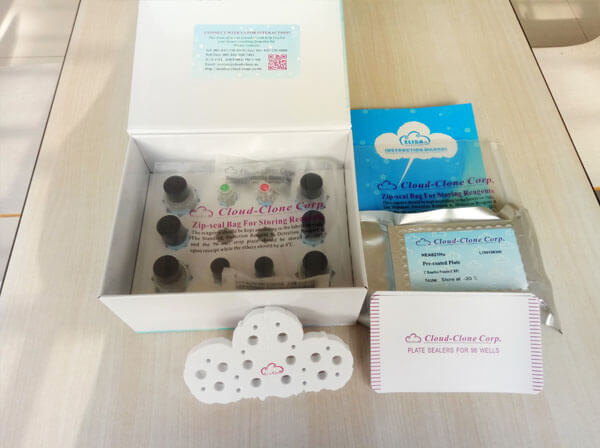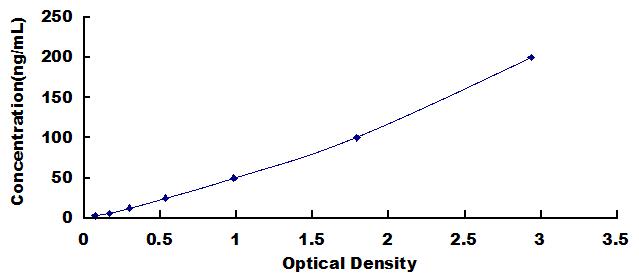ELISA Kit for Anti-Glial Fibrillary Acidic Protein Antibody (Anti-GFAP) 

Intermediate Filament Protein
- UOM
- FOB US$ 630.00 US$ 900.00 US$ 4,050.00 US$ 7,650.00 US$ 63,000.00
- Quantity
Overview
Properties
- Product No.AEA068Hu
- Organism SpeciesHomo sapiens (Human) Same name, Different species.
- ApplicationsEnzyme-linked immunosorbent assay for Antibody Detection.
Research use only - DownloadInstruction Manual
- CategoryInfection immunityNeuro science
Sign into your account
Share a new citation as an author
Upload your experimental result
Review

Contact us
Please fill in the blank.
Recovery
Matrices listed below were spiked with certain level of Anti-Glial Fibrillary Acidic Protein Antibody (Anti-GFAP) and the recovery rates were calculated by comparing the measured value to the expected amount of Anti-Glial Fibrillary Acidic Protein Antibody (Anti-GFAP) in samples.
| Matrix | Recovery range (%) | Average(%) |
| serum(n=5) | 84-103 | 98 |
| EDTA plasma(n=5) | 80-93 | 89 |
| heparin plasma(n=5) | 82-102 | 94 |
Precision
Intra-assay Precision (Precision within an assay): 3 samples with low, middle and high level Anti-Glial Fibrillary Acidic Protein Antibody (Anti-GFAP) were tested 20 times on one plate, respectively.
Inter-assay Precision (Precision between assays): 3 samples with low, middle and high level Anti-Glial Fibrillary Acidic Protein Antibody (Anti-GFAP) were tested on 3 different plates, 8 replicates in each plate.
CV(%) = SD/meanX100
Intra-Assay: CV<10%
Inter-Assay: CV<12%
Linearity
The linearity of the kit was assayed by testing samples spiked with appropriate concentration of Anti-Glial Fibrillary Acidic Protein Antibody (Anti-GFAP) and their serial dilutions. The results were demonstrated by the percentage of calculated concentration to the expected.
| Sample | 1:2 | 1:4 | 1:8 | 1:16 |
| serum(n=5) | 85-96% | 90-97% | 80-97% | 95-103% |
| EDTA plasma(n=5) | 86-101% | 80-101% | 93-101% | 93-105% |
| heparin plasma(n=5) | 80-98% | 86-98% | 85-103% | 81-103% |
Stability
The stability of kit is determined by the loss rate of activity. The loss rate of this kit is less than 5% within the expiration date under appropriate storage condition.
To minimize extra influence on the performance, operation procedures and lab conditions, especially room temperature, air humidity, incubator temperature should be strictly controlled. It is also strongly suggested that the whole assay is performed by the same operator from the beginning to the end.
Reagents and materials provided
| Reagents | Quantity | Reagents | Quantity |
| Pre-coated, ready to use 96-well strip plate | 1 | Plate sealer for 96 wells | 4 |
| Standard | 2 | Standard Diluent | 1×20mL |
| Detection Reagent A | 1×120µL | Assay Diluent A | 1×12mL |
| TMB Substrate | 1×9mL | Stop Solution | 1×6mL |
| Wash Buffer (30 × concentrate) | 1×20mL | Instruction manual | 1 |
Assay procedure summary
1. Prepare all reagents, samples and standards;
2. Add 100µL standard or sample to each well. Incubate 1 hours at 37°C;
3. Aspirate and add 100µL prepared Detection Reagent A. Incubate 1 hour at 37°C;
4. Aspirate and wash 5 times;
5. Add 90µL Substrate Solution. Incubate 10-20 minutes at 37°C;
6. Add 50µL Stop Solution. Read at 450nm immediately.

Test principle
The microtiter plate provided in this kit has been pre-coated with GFAP. Standards or samples are then added to the appropriate microtiter plate wells with a Horseradish Peroxidase (HRP)-conjugated secondary antibody. After TMB substrate solution is added, those wells that contain Anti-GFAP will exhibit a change in color. The enzyme-substrate reaction is terminated by the addition of sulphuric acid solution and the color change is measured spectrophotometrically at a wavelength of 450nm ± 10nm. The concentration of Anti-GFAP in the samples is then determined by comparing the O.D. of the samples to the standard curve.
Giveaways
Increment services
Citations
- Effects of Exposure to 1-Bromopropane on Astrocytes and Oligodendrocytes in Rat BrainPubmed: 23183024
- EFECTO PROTECTOR DEL TRATAMIENTO CON NEUROEPO SOBRE LA GLIA DE LA CORTEZA CEREBRAL EN RATONES TRANSGéNICOS CON LA ENFERMEDAD DE ALZHEIMER.Sld:Source
- Effect of memantine, a NMDA receptor blocker, on ethambutol-induced retinal injuryPubMed: 26704355
- IL-4 Inhibits IL-1β-Induced Depressive-Like Behavior and Central Neurotransmitter AlterationsPubMed: 26417153
- Protective Effect of Oral Hesperetin Against Unilateral Striatal 6-Hydroxydopamine Damage in the RatPubMed: 26700436
- Hypericum Perforatum Hydroalcoholic Extract Mitigates Motor Dysfunction and is Neuroprotective in Intrastriatal 6-Hydroxydopamine Rat Model of Parkinson’s DiseasePubMed: 26119304
- Relationship of orexin (hypocretin) system and astrocyte activation in Parkinson's disease with hypersomnolenceDoi: 10.1111
- Hypericum Perforatum Hydroalcoholic Extract Mitigates Motor Dysfunction and is Neuroprotective in Intrastriatal 6-Hydroxydopamine Rat Model of Parkinson’s DiseasePubmed:26119304
- Effect of memantine: A NMDA receptor blocker, on ethambutol-induced retinal injuryPubmed:26704355
- ESTROGENIC COMPONENTS FOR USE IN THE TREATMENT OF NEUROLOGICAL DISORDERSy2016:0101116.html
- Human plasma glial fibrillary acidic protein and heat shock protein 27 concentrations in acute moderate-intensity aerobic exercise with different durationa825e1e27b0221df9a627769c0f614432e92.pdf
- Comparison of GFAP and HSP27 concentrations in acute moderate-intensity aerobic exercise of different duration2031884
- Carnosine ameliorates cognitive deficits in streptozotocin-induced diabetic rats: Possible involved mechanisms.pubmed:27777064
- Garlic active constituent s-allyl cysteine protects against lipopolysaccharide-induced cognitive deficits in the rat: Possible involved mechanisms.pubmed:27915041
- Troxerutin exerts neuroprotection in 6-hydroxydopamine lesion rat model of Parkinson's disease: Possible involvement of PI3K/ERβ signaling.pubmed:28284752
- Acetyl-l-carnitine protects dopaminergic nigrostriatal pathway in 6-hydroxydopamine-induced model of Parkinson's disease in the rat.pubmed:28199883
- Estrogen receptors and estetrol-dependent neuroprotective actions: a pilot study.pubmed:27799463
- An Intranasal Formulation of Erythropoietin (Neuro-EPO) Prevents Memory Deficits and Amyloid Toxicity in the APPSwe Transgenic Mouse Model of Alzheimer's …articles:journal-of-alzheimers-disease
- Evaluierung von Biomarkern im Liquor cerebrospinalis bei paraplegischen Hunden mit Rückenmarksverletzung:
- Utilization of Glial Fibrillary Acidic Protein and Galectin-3 in the Diagnosis of Cerebral Infarction Patients with Normal Cranial Tomographypubmed:28406123
- Soy isoflavone genistein attenuates lipopolysaccharide-induced cognitive impairments in the rat via exerting anti-oxidative and anti-inflammatory effectspubmed:29102164
- Berberine ameliorates intrahippocampal kainate-induced status epilepticus and consequent epileptogenic process in the rat: Underlying mechanismspubmed:28061403
- The anti-aging protein klotho alleviates injury of nigrostriatal dopaminergic pathway in 6-hydroxydopamine rat model of Parkinson's disease: Involvement of PKA/CaMKII/CREB signaling.pubmed:29107062
- Acrolein-mediated neurotoxicity in growing Wistar male ratsPubmed:30033014
- Mechanisms of death in structurally normal stillbirthsPubmed: 30231013
- Berberine ameliorates lipopolysaccharide-induced learning and memory deficit in the rat: insights into underlying molecular mechanismsPubmed: 30456649
- Trigonelline protects hippocampus against intracerebral Aβ (1–40) as a model of Alzheimer's disease in the rat: insights into underlying mechanismsPubmed: 30421246
- INSTITUTO DE CIENCIAS BÁSICAS Y PRECLÍNICAS “VICTORIA DE GIRÓN” DEPARTAMENTO DE HISTOLOGÍA
- The Administration of the New Pyrimidine Derivative—4-{2-[2-(3, 4-Dimethoxyphenyl)-Vinyl]-6-Ethyl-4-Oxo-5-Phenyl-4H-Pyrimidine-1-Il} Benzsulfamide Restores the …
- Inhibition of Receptor for Advanced Glycation End Products as New Promising Strategy Treatment in Diabetic RetinopathyPubmed: 32165929
- Diosgenin Attenuates Cognitive Impairment in Streptozotocin-Induced Diabetic Rats: Underlying MechanismsPubmed: 32526752
- Intraoperative dexmedetomidine for prevention of postoperative delirium in elderly patients with mild cognitive impairmentPubmed: 28593326
- Quercetin mitigates monosodium glutamate-induced excitotoxicity of the spinal cord motoneurons in aged rats via p38 MAPK inhibitionPubmed: 32622428
- The Predictive Role of Neurobiochemical Markers in Multiple Sclerosis.
- Paeonol Protects Against Intrastriatal 6-Hydroxydopamine Rat Model of Parkinson's Disease33995926
- PHARMACOLOGICAL SCREENING OF A POTENTIALLY EFFECTIVE COMPOUND FOR THE TREATMENT OF CHRONIC TRAUMATIC ENCEPHALOPATHY?¡
- The bee venom active compound melittin protects against bicuculline-induced seizures and hippocampal astrocyte activation in rats34808488
- P2Y2 Receptor Mediated Neuronal Regeneration and Angiogenesis to Affect Functional Recovery in Rats with Spinal Cord InjuryPubmed:35154311















